Olympus E-520
-
-
Written by Gordon Laing
Olympus E-520 design and controls
The Olympus E-520 is a traditionally-styled DSLR with a decent sized grip. At first glance it appears externally identical to its predecessor, but there’s a few subtle variations we’ll mention in a moment. We’ve pictured it below alongside what’s likely to be its biggest rival, the Canon EOS 450D / Rebel XSi. The Canon’s fitted with the EF-S 18-55mm IS kit lens, while the Olympus is fitted with the standard 14-42mm kit lens.
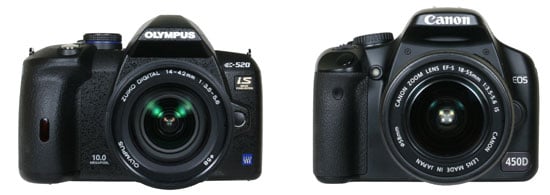 |
Measuring 136x92x68mm, the E-520 is 7mm wider and 6mm thicker than the Canon, but 6mm shorter. The E-520 body-only comes in slightly lighter at 460g to the 475g of the 450D / XSi, but the Olympus battery is heavier, making its body plus battery weight a little more. There’s not a lot in it though, which is quite impressive for the E-520 considering it features built-in stabilisation.
The body size and weight may be similar, but fit their respective kit lenses and there’s clear differences as viewed from above. The E-520 when fitted with the standard 14-42mm kit lens is comfortably shorter than Canon fitted with the EF-S 18-55mm IS; this can make quite a difference if you’re squeezing either camera into a pocket or a small bag. If you’re after something smaller still, consider fitting the slim Olympus 25mm pancake lens.
Both the E-520 and 450D / XSi have decent-sized grips with roughly the same space between them and the lens barrel for your fingertips. The E-520’s grip is slightly higher though, and as seen from above is clearly much more rounded, better fitting the palm of your hand, albeit resulting in a wider body. As always, you’ll need to pick them up for yourself to see which looks and feels better in your own hands.
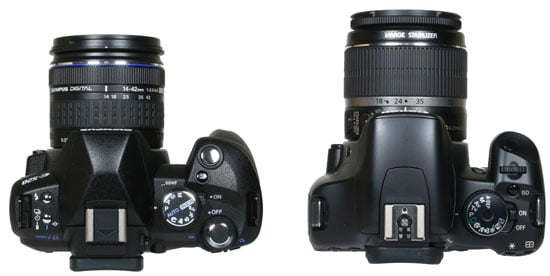 |
In terms of build quality the E-520 is the same as its predecessor and roughly equivalent to the 450D / XSi. The E-520’s glass-reinforced plastic shell feels solid and well-assembled without any creaks or poor joins. The textured finish around the grip of the earlier E-510 remains, but this is no longer a differentiator with the rival Canon. While the smooth finish of the earlier 400D / XTi could look quite plasticky, Canon has wrapped the newer 450D / XSi’s grip in a classier textured finish.
One interesting difference between the E-520 and its predecessor is the availability of a new PT-E05 underwater housing. Previously the smaller E-410 offered an underwater option as a selling point over the E-510, but now there’s been a role-reversal and it’s the E-520 which has the optional housing, while the E-420 has to stay above water. The new PT-E05 is waterproof down to 40m, but despite physical similarities between the E-520 and the E-510, Olympus told us it won’t work with the older body.
The E-520’s control layout is identical to its predecessor, although Olympus has made some cosmetic changes. Like the E-420, the green labelling has been switched to a blue colour which is more easily visible to those with colour blindness. The buttons on the rear are now coloured black instead of grey, and both the Mode and Control dials have redesigned exteriors. The biggest difference externally is the slightly larger screen on the E-520, more of which below.
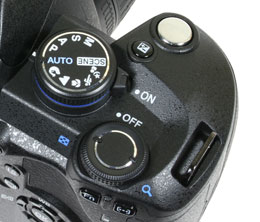 |
The upper right surface is home to the main command dial which offers Auto, Program, Manual, Aperture and Shutter Priority modes, along with direct access to five popular scene presets and a dedicated Scene position which provides access to the full selection of 20 via an on-screen menu; each of these presets is accompanied by an example image and brief description. Eagle-eyed Olympus fans will have spotted two more presets than the E-510 – these are for use with the optional underwater housing. Note the Panorama preset which exploits Live View for aligning images will only work if you’re using an Olympus xD memory card.
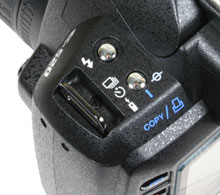 | |
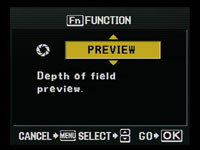 | |
To the right of the main command dial is a single thumb dial, used to adjust the aperture, shutter speed, playback magnification or various menu options. Between the command dial and the shutter release you’ll find an exposure compensation button.
On the upper left hand side of the body are a pair of buttons controlling the drive mode and flash options.
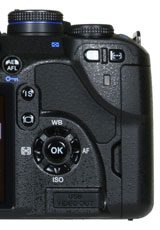 |
Round the back there’s four buttons to the left side of the screen for image playback, image delete, accessing the main menu and switching the on-screen information. To the right of the screen are a traditional four button layout with an OK button in the middle for navigating and confirming options, along with an AEL / AFL button by the viewfinder and pair of buttons to the upper right of the screen which activate the Image Stabilisation and Live View features. Two further buttons in the upper right corner provide a programmable Function control and AF frame adjustments.
Like its predecessor, the E-520’s four main buttons on the back also offer direct access to a number of key menus: push up for White Balance, right for AF options, down for ISO and left for the metering modes. This is a different approach to the E-420 which doesn’t offer direct access using these buttons.
Like both its predecessor and the E-420 though, the E-520 also lets you adjust a wide range of settings by pressing the OK button on the back and using the four direction keys to highlight the desired option on-screen. You can then either press OK to present a dedicated menu for that item, or simply turn the thumb wheel to directly adjust it. As explained in our E-420 review, this is a very quick and easy way to work which we’ll fully describe in our Features section and demonstrate in our video tour. Between it and the direct access to key menus, the E-520 has all adjustments covered.
Olympus E-520 flash
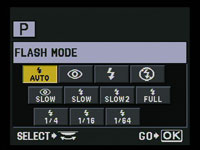 |
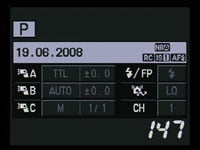 |
Pressing the flash button once pops up the built-in flash and pressing it again presents a wide variety of options including Auto, redeye, always on, forced off, slow sync with or without redeye, slow sync with rear curtain, and four different power options. The main menu additionally offers flash compensation settings (+/-3 EV) and flash power bracketing; the latter isn’t available on the E-420. You can also set a custom option which prevents the flash from popping-up automatically if preferred.
Following the E-420, a new feature for the E-520 over its predecessor is wireless flash control when used with the FL-50R and FL-36R flashguns; the built-in flash is used as a controller.
Flash exposure settings can be assigned to multiple units in three different groups and includes auto, manual, TTL and Super FP control; the latter is designed for use with the FL-50R and FL-36R and allows sync speeds up to 1/4000. The normal flash sync speed is 1/180.
Olympus E-520 viewfinder
|
The Olympus E-520’s viewfinder is identical to that of the E-510. It shares the same Penta-mirror system to deliver 95% coverage and 0.92x magnification with a 50mm lens set to infinity. Unlike most DSLRs which have their shooting information running along the bottom, the E-520, like all Four Thirds DSLRs other than the E-3, has its information to the right side of the frame.
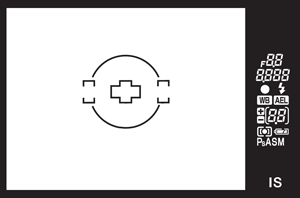 |
You’ll see the aperture, shutter, exposure mode, metering mode, exposure compensation (expressed numerically up to +/-5EV), a battery icon and indication on whether IS is enabled or not. You sadly won’t find the ISO displayed in the viewfinder, but it is at least shown on the main screen at all times.
Like its predecessor, the actual viewfinder on the E-520 appears smaller than other DSLRs. Typically it looks around the same height as models like Canon’s EOD 400D / XTi, but narrower to match the squarer 4:3 aspect ratio of the images. This makes it noticeably smaller than the viewfinders on models like the Nikon D80 and the Canon EOS 450D / XSi.
This is a downside to the E-520, although if you don’t have another DSLR alongside, you can get used to it pretty quickly; it should also be noted the viewfinders of Sony’s A300 and A350 aren’t exactly large either. Ultimately the size of the viewfinder image is a very personal thing, so we’d recommend trying the E-520 for yourself and seeing if it’s a deal-breaker, or something you could happily live with.
Olympus E-520 Screen and Live View
The Olympus E-520 is equipped with a 2.7in screen with 230k pixels, which we believe is the same type used on the E-420. This is one of the main external differences between it and the 2.5in screen of its predecessor, but there’s more than just 0.2in over the E-510. The E-520’s screen also boasts increased contrast, a broader colour gamut and a wider viewing angle of 170 degrees. You can adjust the screen brightness and colour temperature, although the latter will only impact images viewed in playback.
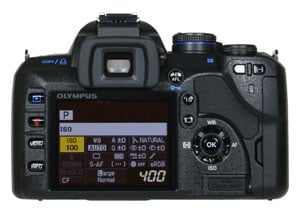 |
In use the screen is certainly bright and vibrant, but making it equally useful are reflective properties after the backlight has switched off. This makes the various on-screen settings or even Live View display very easy to view during intense, direct sunlight. An annoying aspect inherited from the E-510 and E-4xx though is the lack of proximity sensors which automatically switch the screen off when you look through the viewfinder. To be fair it does switch off when you half-press the shutter, but we’d ultimately prefer a sensor-based approach like most of its rivals.
The E-520 offers Live View facilities which are identical to those on the E-420. Like most DSLRs these days, excluding the Sony Alpha A300 and A350, Live View on the E-520 employs the main sensor to deliver the feed; this may incur delays, but has the benefit of previewing exactly what you’re going to capture.
To activate Live View on the E-520, you’ll need to press the monitor button on the back of the camera. The mirror will then flip up and just over a second later the live image will appear on the screen; the view shown represents 100% of the frame and while the refresh may not be quite as fluid as the best compacts, it’s certainly pretty smooth.
The earlier E-510 only offered one autofocus option in Live View: you’d press the AEL / AFL button to drop the mirror, take an AF reading, before it flipped back up again to continue composing. This interrupted the view and understandably made some noise.
The E-520 also offers this option when its Live View AF menu is set to ‘Sensor AF’, and like the E-3 and E-420, the view is temporarily frozen rather than going dark for a moment. If the subject’s still, you may not even notice. New to the E-520 and E-420 though are two additional AF options: ‘Imager AF’ and ‘Hybrid AF’.
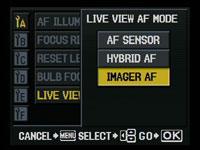 |
Imager AF is the contrast-based option that’s a headline feature on the E-520 and E-420. It allows both cameras to autofocus in Live View without dropping their mirror or interrupting the view. It also allows both bodies to extend their relatively basic 3-point AF system to one with 11 points while additionally supporting face detection. If face detection is enabled and the E-520 spots a human subject, their face will be framed by a white box which tracks them across the frame.
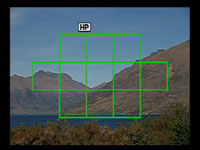 |
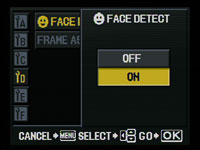 |
Like the E-420, Imager AF is the default setting on the E-520 and will certainly make anyone coming from a point and shoot feel at home. While you can still autofocus by pressing the AEL / AFL button on the back of the camera, you can alternatively half-press the shutter release as you would outside of Live View. In practice this feels very natural and while the process is slightly slower than the ‘Sensor AF’ option, the lack of interruption or noise while focusing will be preferable for most.
Imager AF will however only work with lenses which support the feature, and at the time of writing, there were only three from Olympus: the 14-42mm and 45-150mm kit lenses and the new 25mm pancake model. To be fair though, these will be the most common lenses used with the E-520. Note if you have an older version of the kit lenses, you may need to update their firmware to support Imager AF, but this is a quick and painless process using the supplied Olympus Master software.
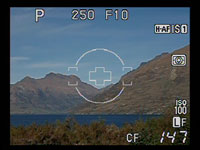 |
Other lenses fall back on either the traditional Sensor AF system or the new Hybrid AF option which uses a combination of the other two modes. Hybrid AF roughly but quietly focuses using the contrast method when you half-press the shutter, but unlike the Imager AF mode, then takes a reading from the traditional 3-point AF sensor when you fully press the button to take the picture. See screenshot left.
Both the Imager AF and Hybrid AF result in several mirror flaps as you take the photo, but the Hybrid mode is slightly slower. You can see a demonstration of all three Live View modes in our video tour.
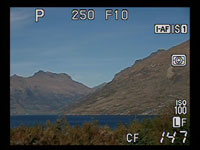 |
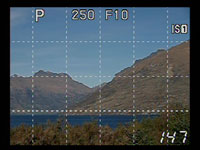 |
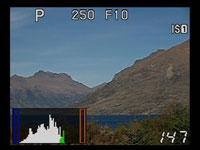 |
Pressing the Info button during Live View cycles between a clean view, one with a choice of alignment graphics, one with detailed shooting information, followed by a live brightness histogram, the Enlarged display option and finally the Perfect Shot Preview.
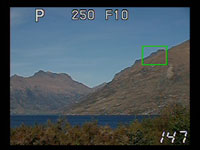 |
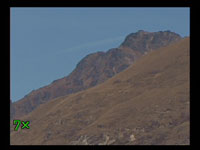 |
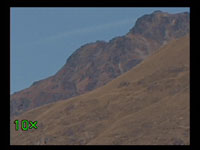 |
Enlarged display presents a small green frame on the screen which can be moved around using the cross keys. Then when it’s over a point of interest, press OK and turn the thumb dial to switch between 7x and 10x magnification (the 5x option of the E-3 isn’t present). This allows you to carefully check the focus and is especially useful in manual focus mode, although once you’re zoomed-in, the cross-keys are locked from moving the frame around until you fully zoom back out.
Perfect Shot Preview builds on what was already offered on Olympus compacts by showing four different thumbnail versions of the same composition which are all updated in real time. You can either choose for the thumbnails to show variations in exposure compensation or white balance, and seeing four different options on the screen at once certainly makes it easier to choose the right one.
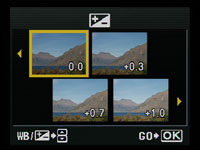 |
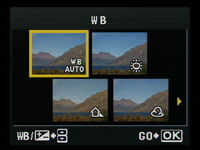 |
You can also preview white balance and exposure compensation on the full image in Live View, along with seeing a depth-of-field preview. The E-520 will increase the gain as required to maintain the image brightness during the depth-of-field preview, which under darker conditions can result in a monochrome and slightly grainy image, but the final result of course looks fine.
So with 100% coverage, live histogram, a choice of alignment grids, magnified manual focus assistance, previews of white balance, exposure compensation and depth of field, not to mention the choice of contrast-based AF, the E-520 delivers a powerful and comprehensive live view experience. The only thing that’s really missing is a flip-out screen, for which you’ll need to go for the flagship E-3 model.
Olympus E-520 menus
Like its predecessor, the E-520 uses its colour monitor to display shooting information. Gone is the option to scale the fonts for a coarse or detailed view, and instead you just have the latter on the E-520. As such it displays a vast amount of information at a glance – in fact the same as the E-3 with the new addition of face detection.
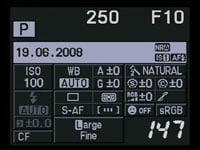 |
You’ll see the Shutter and Aperture value, an exposure compensation scale, the shooting mode, date, flash, IS and NR settings, the sensitivity, white balance (plus adjustments), Picture Mode, Sharpness, Contrast, Saturation and Gradation, Colour Space, Face Detection on / off, AF Area, Metering, AF and Drive modes, Flash mode and flash compensation, memory card in use, image size and quality and number of shots remaining. Battery life is shown with a basic two segment icon.
Like its predecessor, the E-520 offers a variety of ways to adjust settings. Like many DSLRs, the four direction buttons on the back provide direct access to the White Balance, AF, Sensitivity and Metering menus. This would be adequate, but like its predecessor, the E-520 also offers an alternative means of modifying a broad variety of settings without requiring dedicated buttons or delving into menus.
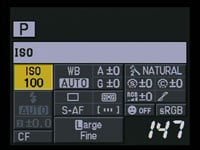 | 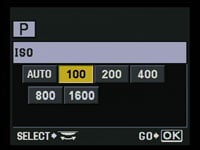 |
With the camera powered-up, press the OK button and the ISO value is highlighted in yellow. You can then turn the thumb-dial to change the setting, or if you prefer, press OK again to enter a dedicated adjustment menu. Alternatively with ISO highlighted, just use the up, down, left and right buttons to highlight any other option, before then using the dial to adjust it, or pressing OK to again view a dedicated menu. In practice it’s quick, intuitive and works really well. We’ve got a demonstration in our E-520 video tour.
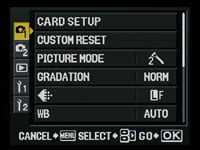 |
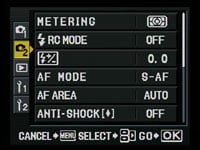 |
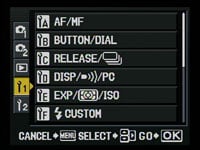 |
Pressing the Menu button presents the E-520’s options arranged into five vertically-tabbed pages: two for recording, one for playback and two for setup. These pages offer alternative access to the dedicated adjustments described above, along with no fewer than 46 custom settings which include setting the Live View AF mode, choosing the maximum exposure in Bulb, configuring the function button, swapping the alignment grid and customising the quality settings.
 |
During playback, turning the thumb-dial to the right zooms-in on the image, while turning it to the left presents a number of thumbnails, first four, then nine, then 16, 25, 49, and even 100, followed by a fun calendar view of the current month showing a tiny photo thumbnail on the days you took a photo.
With an image filling the screen in playback, pressing the Info button cycles through RGB and brightness histograms, along with options to flash any clipped highlight or shadow areas. The histograms look a little coarse compared to those on rival models, but it’s still good to have this number of options.
 |
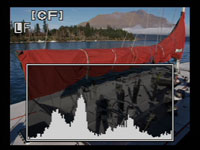 |
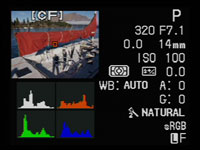 |
Turning the camera to a portrait orientation also turns the image by 90 degrees, either clockwise or anti-clockwise. That’s a nice feature to ensure portrait images fill the screen during playback, but it’s a shame the shooting menu doesn’t also rotate as it does on Sony’s Alpha models and the Nikon D60.
Olympus E-520 battery and connectivity
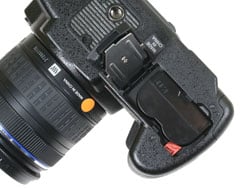 |
The E-520’s powered by the same PS-BLM1 1500mAh Lithium Ion battery pack as the E-510 and a number of other Olympus bodies, and it’s supplied with the BCM-2 mains recharger; the faster BCM-1 charger is optionally available
Olympus quotes up to 650 shots under CIPA conditions, although this will obviously vary depending on how much you use Live View and the Image Stabiliser.
The E-520 can handle both xD and Compact Flash memory cards using two separate slots behind a door on the right side of its body, although like the E-420 and E-510 before it, you still can’t record to both simultaneously. And finally, behind a small flap on the rear of the E-520 you’ll find a single port delivering both USB and TV connectivity; the camera’s supplied with two different cables for use with this port.




